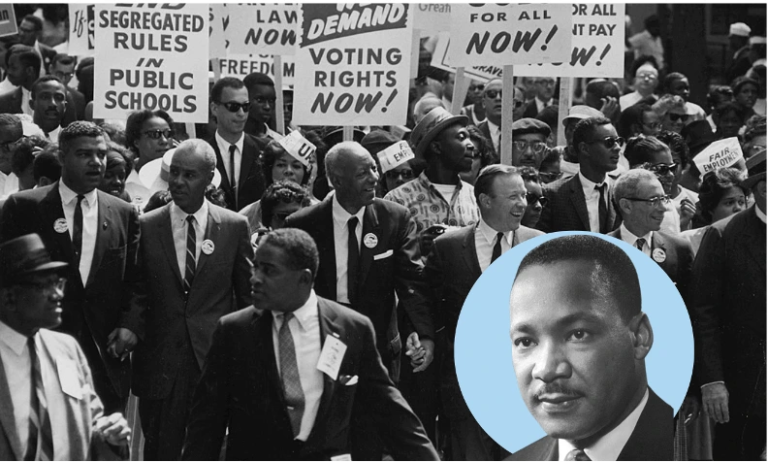What Was the Civil Rights Movement in America?
The Civil Rights Movement is a story of the pursuit of equality by some incredible figures who had the resilience and courage to clear the path for equality and inclusivity in America.

Overview of the Civil Rights Movement
The Civil Rights Movement was a fight for social justice and equality by African Americans to get equal rights in the United States. It was a movement where black people stood up against discrimination and changed society in the 1950s and 60s.
Pre-Civil Rights Era Conditions for African Americans
The core of the issue was the unequal treatment African Americans were subjected to during the pre-Civil rights era. During the 1860s black people started taking more leadership roles and the Constitution (14th amendment) gave them equal protection under the law and a right to vote(15th amendment).
However, the white Americans weren’t happy to give their former slaves equal rights, especially in the South. Therefore, to marginalize black people Jim Crow laws were established. These laws were mainly prevalent in Southern America where economic inequality and restricted voting rights were commonplace for Black Americans.
Early Activism and Resistance
Even in Northern states, where Jim Crow laws weren’t adopted, black people still faced discrimination at jobs, schools, etc. These inequalities were questioned by groups like the National Association for the Advancement of Colored People (NAACP), and decisions like the Brown v. Board of Education ruling began to weaken segregation. Rosa Parks the courageous woman who refused to give up her bus seat to a white American started the Montgomery Bus Boycott and sparked resistance to segregation.
Key Figures of the Civil Rights Movement
Let’s move on to the titans who shaped the direction of this movement. Malcolm X and Martin Luther King Jr. made peaceful yet loud demands for justice and served as symbols of optimism. Fannie Lou Hamer, Rosa Parks, and others were part of this chorus of change.
- Martin Luther King Jr. – The renowned Nobel Prize winner’s leadership during the Montgomery Bus Boycott and his position in the Southern Christian Leadership Conference (SCLC) made him the face of nonviolent resistance. Martin Luther King Jr’s striking “I Have a Dream” speech delivered at the 1963 March on Washington became a slogan for equality.
- Malcolm X – Malcolm X influential black nationalist who was an advocate for black empowerment. He was a former Nation of Islam spokesman and one of the founders of the Afro-American Unity organization.
- Rosa Parks – There is no ignoring Rosa Parks, known as the “Mother of the Civil Rights Movement.” Her courage to not give up her seat on that bus in Montgomery set off a chain reaction that would fan the flames of change. Her tiny deed of standing up to injustice had far-reaching effects.
- John Lewis – One of the most crucial players in the fight for the right to vote was John Lewis. His dedication to justice and equality was evident from organizing the Selma March to serving in Congress.
Significant Events of the Civil Rights Movement
- March on Washington (1963)
On August 28, 1963, more than 200,000 people gathered for the March on Washington at the nation’s capital. It was organized by leaders like A. Philip Randolph, Bayard Rustin, and Martin Luther King Jr. A highlight of the march was the “I Have a Dream” speech by Martin Luther King Jr. which reverberated across the Lincoln Memorial. This event permanently altered the course of the civil rights movement.
- Birmingham Campaign (1963)
The Birmingham Campaign demonstrated the effectiveness of peaceful demonstrations. Nonviolent protests were met with violent suppression by police who unleashed dogs and fire hoses. This brought attention to the reality of segregation and emphasized how urgently reform is needed. The campaign led to President John F Kennedy proposing the most far-reaching civil rights legislation in 1963 which was eventually passed by President Lyndon B. Johnson after Kennedy’s assassination.
- Voting Rights Act (1965)
In 1965 after a protest for voting rights for African Americans on a bridge outside of Selma, voting rights legislation was passed to remove obstacles in African Americans’ ability to participate in politics. It was a big step toward ending the discriminatory practices as people could exercise their right to vote.
Opposition and Challenges
Of course, the road to change was not without its bumps and obstacles. There was strong opposition such as the violent activities committed by the Ku Klux Klan against civil rights campaigners. Sadly, many leaders of this movement were assassinated such as Malcolm X and Martin Luther King Jr.
Furthermore, African Americans were affected by internal divides in their methods and ideology within the movement. It was a careful balancing act highlighting the intricacy of the civil rights movement.
Legacy and Ongoing fight for racial equality
The Civil Rights Act of 1964, the Voting Rights Act of 1965, and the Fair Housing Act of 1968 are just a few of the laws that highlight the Civil Rights Movement’s lasting influence. These legislative achievements sparked a revolution in society that brought about integration and desegregation.
The movement had a significant effect on social views as well. Where public areas and schools were merged, long-standing racism was challenged, and a more welcoming attitude was promoted.
Nonetheless, the struggle for racial parity persists. The Black Lives Matter movement tackles current concerns including institutional racism and serves as a reminder that the fight for justice is still ongoing, carrying on the legacy of the Civil Rights Movement.
Conclusion
The Civil Rights Movement showcased the strength of a group, the bravery of individuals willing to fight for justice, and the ability to persevere in the face of adversity. The voices of black demonstrators who marched and battled for justice characterized the transition from segregation to equality. This movement inspires us to keep working toward a society in which equality is a reality rather than a dream.
